Your baby is six months old. He still gets mom's milk and you understand that it's time to introduce complementary foods! When is it better to start feeding a baby who is breastfeeding? - It depends on the health status of your crumbs. Pediatricians determine six months of age as optimal for the introduction of complementary foods. Early feeding can trigger the development of atopic dermatitis or gastrointestinal tract disease.
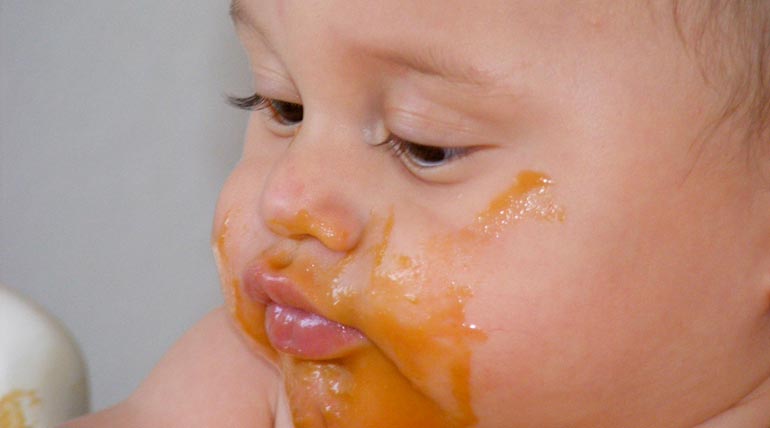
By six months, the child’s stomach and intestines are ready to receive other food. However, there are exceptions to any rule if the weight of your baby does not consistently reach the norm. then the doctor may suggest that you feed the baby already in 4.5 months. If the baby has allergies, doctors will advise you to wait with a change in diet for up to seven months.
We read in detail: how to determine that the child is ready for feeding - 10 signs
No matter how valuable mother's milk, it can no longer provide the actively growing body of the baby with the necessary substances. For the organic development of the digestive system, fiber, vegetable protein, and dietary fiber are needed. With age, it will be more difficult to accustom a baby to new food. But the baby has a chewing reflex, teeth are actively growing, a bite is forming. Solid food contributes to better development of the baby's jaw apparatus.
How to introduce complementary foods
- Use a small spoon (preferably coffee);
- Do not force the baby to eat everything that you offered. If the baby does not have an appetite, just do something else with it. And after a while, offer food again;
- In the early days of complementary feeding, give a new product little by little, just a few grams, so that the ventricle of the baby gets used to the new food. Gradually increase the serving;
- Get a notebook (Baby Diary). Write down in it what product you gave to the baby, when and how much, how the baby's body reacted to new food. The notes will come in handy if something is wrong with the baby: an upset stomach, an allergic rash, etc. appear. You can quickly determine which product caused an undesirable reaction;
- It is better if the baby is sitting in a high chair during feeding;
- Introduce another product when the baby’s stomach gets used to one type of feeding. The interval between the introduction of new products is from 3 to 7 days;
- After complementary feeding, be sure to attach the baby to the chest. Mother's milk is still the main food for the baby.
(Click on the image to enlarge)
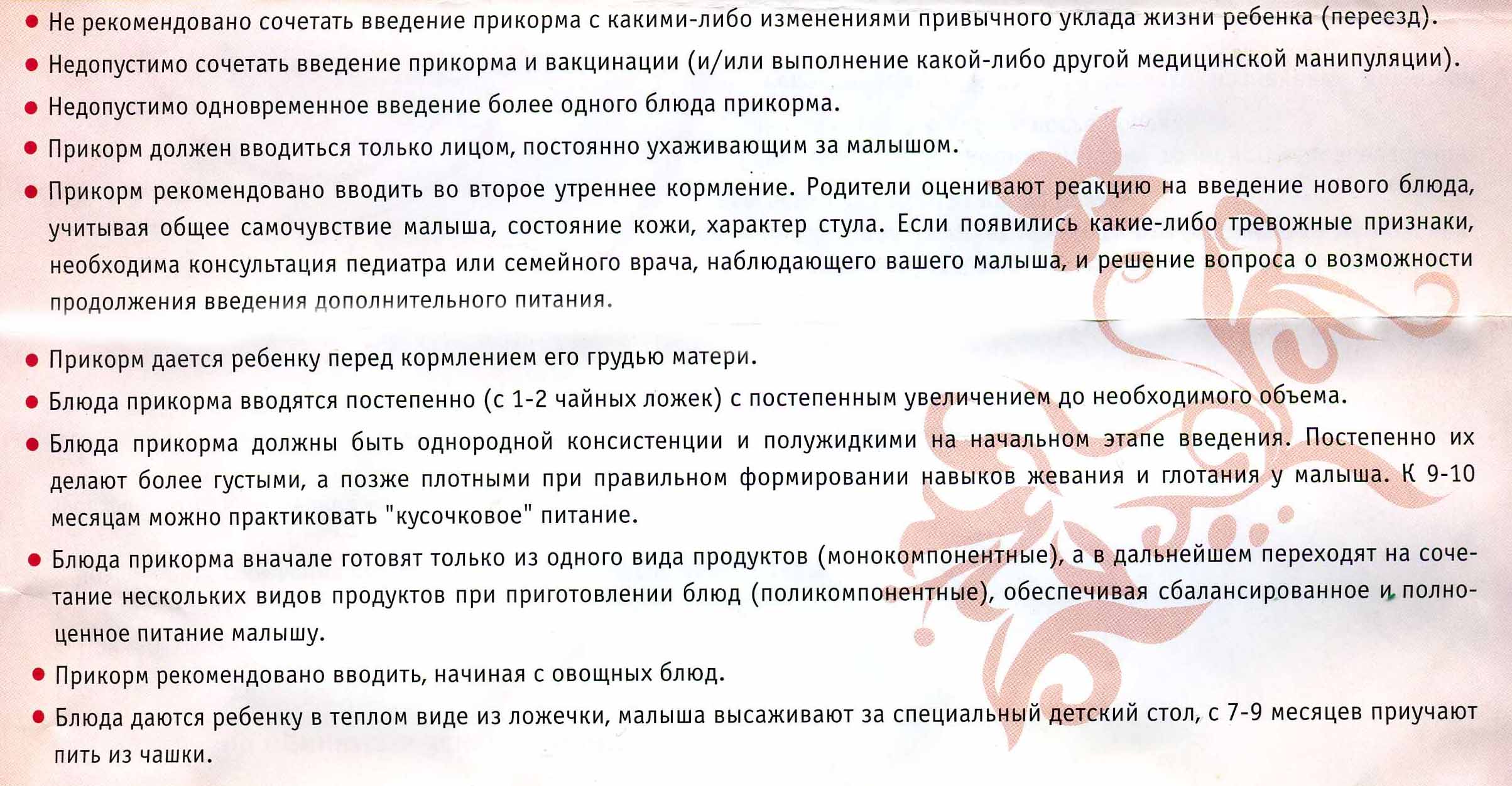
Breastfeeding feeding table
(Click on the image to enlarge)

* The numbers in the table related to products are average. Do not try to “shove” the entire recommended amount of food into the child. Does the baby turn his head away from the spoon? Do not make him eat up. Take away the food, and give the baby a breast.
Choose a feeding scheme
Pedagogical feeding
It is based on the baby's interest in the food that adults eat. The main goal here is not to feed the child, but to introduce new food, to form taste sensations, to teach to chew. Give him a meal from his plate. Of course, it must be prepared - chopped, mashed potatoes.
What products can be offered crumbs?
First of all, vegetables, cereals, fruits, dairy products (kefir, natural yogurt), egg yolk, meat (rabbit meat, turkey, chicken, chicken, beef, pork - meat in a child’s diet - the rules for introducing meat feeding), sea fish (hake, cod, sea bass), legumes.
First, the baby just tastes the food, learns to distinguish the taste, chew it. Something he likes more, something less. Gradually, he will eat more and more. An additional advantage of this method is that the infant’s social circle expands, he copies the movements of adults, learns to take food by hand from a plate and put it in his mouth.
At first, while he learns new skills, keep the baby on his lap. When the baby is sitting firmly, he can hold a spoon well in his hand, put him in a special high chair. From 8 to 10 months, teach yourself to eat with a spoon yourself. It is important to be patient. If the baby got into the food with his hands or puts it first with his hand in a spoon, and then brings it into his mouth, you do not need to scold him, grab a spoon and feed it yourself. Gradually, the baby will learn to do everything right. Let him do everything himself under your supervision. Otherwise, your child will simply lose the desire to do this. (see how to teach a child a spoon)
I remember very well how I tied my daughter a long oilcloth - an apron in the front, put her in a high chair, and laid a film around the floor, which was completely smeared with food at the end of feeding. But after a month the baby ate on her own (under my supervision).
It often happens that the baby eats well, he likes the food, and he requires his mother to give him more. It is important to have a sense of proportion. Overeating will result in poor health, stomach pain, and digestive upset. Gradually, the child will develop a sense of proportion in food, accuracy, he will acquire the skills of proper behavior at the table. Your task is to patiently, step by step, help him in this.
Feeding baby food
(Clickable)
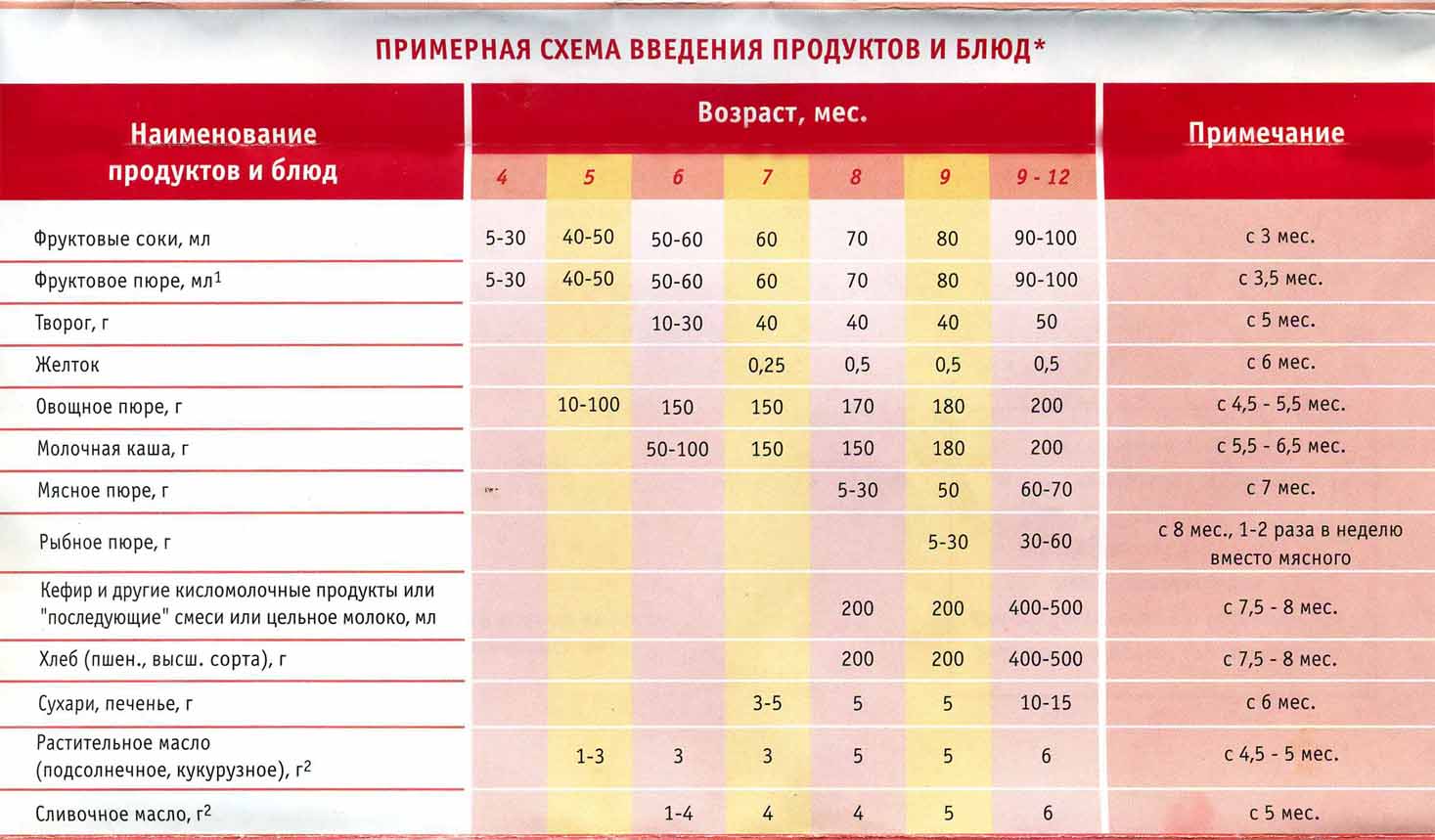
About ten years ago, complementary foods for infants began with fruit juices and mashed potatoes. Now the opinions of doctors are divided, many speak out in favor of vegetables. Motivated by the fact that fruits, due to the sweet taste, form an addiction to sweets in a child, they can provoke the development of allergies and cause indigestion. The famous Ukrainian doctor Komarovsky suggests starting with kefir and cottage cheese. They do not overload the baby’s liver, as their composition is similar to breast milk.
See the opinion of Komarovsky:
It is difficult to say whose opinion is correct, because no special studies of this problem have been conducted. Therefore, when choosing feeding options, rely on the opinion of the pediatrician who has been observing your baby from birth.
However, for this type of complementary foods there are rules:
- First, make mashed potatoes from one type of product. If it is fruit, start with an apple; if it is vegetables, it is better to take zucchini or cauliflower. These products are hypoallergenic, so you can not be afraid to get an allergy.
- You can take the puree ready, it’s better to cook it yourself. Boil all vegetables and fruits, except bananas, or bake in the oven, then chop with a blender. At the same time, there will be no lumps in the puree, with which crumbs can choke.
- Dress vegetables with vegetable oil (ideally olive oil).
- Do not sweeten or add salt to foods for up to a year.
- Watch the baby's stool. If undigested pieces of food appear in it, it’s not scary.And if the stool suddenly changes color, becomes liquid, or, conversely, the child has constipation, a rash appears, remove new food for at least two to three weeks. If you gave the child beets, then urine and stool will turn pink - red. This is natural and not dangerous.
- Porridge can be offered to the baby a month after the vegetables. Groats for cereals must be washed, dried, chopped (conveniently in a coffee grinder). Start with buckwheat, rice, corn porridge, boiled in water. They do not contain gluten - gluten, causing constipation, allergies. It is good to add breast milk to the prepared porridge. From eight months you can cook semolina, oatmeal and mixed cereals. (In detail about porridges)
- If you started complementary foods with vegetables, then it's time after cereals to offer your baby fruit puree. The first purees are made from green and yellow fruits, so there is less risk of developing allergies.
- After the fruits we accustom the baby to meat, fish, give crackers and cookies to gnaw.
- Do not forget to offer your baby a chest every time.
- As the child becomes accustomed to new food, one breastfeeding (usually lunch), we try to completely replace with complementary foods. If the baby still requires a breast, do not refuse him.
- Invite your baby to drink boiled water. With the introduction of solid food, the need for fluid increases. If he refuses - do not insist, that means he has enough of your milk.
- From 8 to 9 months, stop using the blender, just knead solid foods with a fork. The child needs to learn how to chew food.
- With extreme caution, give new products to a child who is prone to allergies. Start literally with microdoses of one to two grams, increasing them a little bit every day.
We read:
[sc: rsa]
10 rules on when to introduce complementary foods
The child refuses to eat new food - what to do
It happens that the baby does not want to try new food, spits, cries. What to do? The first is not to scold the baby. This will only frighten him, cause an even greater aversion to food. Take it with you when you eat yourself, but do not try to “shove” food into it. Let me just watch how other family members eat. If he asks for it, give it to me. Do not turn on the TV while eating, remove anything that can distract the baby from the food process. If he gets tired or drops something, do not be indignant, calmly remove and pay attention to the baby, as others gently eat. Usually these measures are enough for the baby to show interest in food. Recommended on the topic: what to do if the child does not want to eat complementary foods >>>
Refusal of food
For a baby who is breastfeeding, breast milk for a year is the main type of food. Therefore, do not try to give babies a large amount of solid food. Those figures that are offered in the tables are advisory in nature. Otherwise, you can overdo it and get digestive problems in the baby. Follow the reaction of a small organism, consult a doctor, observe in all measure, and your baby will actively grow and develop.
Read on: feeding of children on artificial feeding >>>

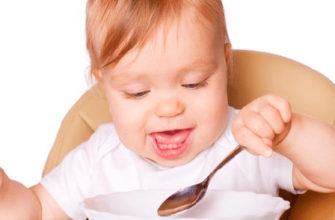

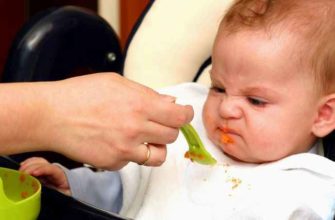

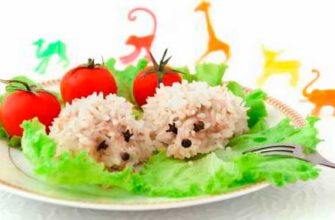



With the eldest, it was difficult for us with complementary foods. At six months, she did not want to eat it, spat and choked. I haven’t tried it before. I still don’t like fruit purees, although I know that many children eat them well. What she ate well was milk, some porridge. Vegetables are so-so, under the mood.
Mine basically ate without problems. Yes, he didn’t need much, and so he was gaining weight too actively. Potgmu, I did not try hard to feed. Rather give a try. So he ate milk.
I gave pedicure. Almost all products except all kinds of harmfulness of course. What she cooked for herself, she fed the baby. The main thing is to get fresh. And you don’t have to bother with the blender, and we didn’t even try any canned food.
Unfortunately, the son refused early feeding, and the public pressed that it was necessary! I still remember with a shiver the noodles with meat pounded in a blender. In other matters, it was meat that was his first serious lure, no vegetables and bananas. The man!))
We, too, were breast-fed for a long time, but a very daughter loved fruit complementary foods - bananas, apples, carrots ... I don’t know who had the full nutrition for WHO. Probably only in the recommendations?)
We started complementary foods like this:
In five months, you can juice 40-50ml. , Fruit puree 40-50g. , Vegetable puree 10-100g. I did so 6.00 - mixture or milk
10.00 - milk or mixture + fruit puree
14.00 - milk or mixture + juice
18.00 - Vegetable puree + juice
22.00 - mixture or milk
But to introduce juices and mashed potatoes gradually and by the end of the month one feeding can be replaced with mashed potatoes with juice. I cooked porridge for the first couple of days, but it sprinkled on the child, and then only grew on Materna’s porridge. We buy through baby1care, we take the mixture there) At six months I added porridge and cottage cheese for breakfast and increased the volume for dinner.
I have been feeding my baby as recommended by WHO, from 6 months starting with mashed vegetables. It has long been proven what is useful and what is not, and it is recommended to start complementary foods at a certain age and with certain foods. Why continue to feed babies from 3 months old with apple juice and yolk, etc., adding unnecessary problems in the future
I don’t understand why fruit juice is three months old. Generally a strange article. According to WHO, complementary foods are recommended from 6 months, but not from 3 months ...
I agree with the commentators above. Why do babies need juice from 3 months? What nonsense? People read, then spoil the digestive tract for children